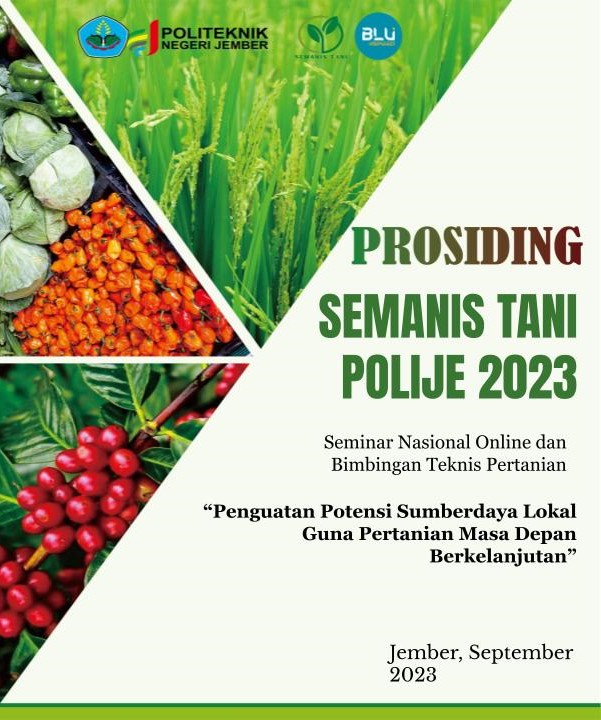Pertumbuhan Dan Hasil Padi (Oryza sativa. L) Melalui Aplikasi Zink Sulfat
DOI:
https://doi.org/10.25047/agropross.2023.501Kata Kunci:
pandanwangi rice, photosynthesis rate, zinc sulphateAbstrak
East Java rice production in 2021 reach 9.79 million tons.ha-1, but it decrease to 9.69 million tons.ha-1 in 2022. One effort to increase rice production can be done by adding zinc sulfate. Zinc plays a role in increasing the photosynthetic metabolism of plants, thereby it’s triggering growth and yield of rice. This study aims to examine the effect of the addition and time of application of zinc sulfate on rice growth and yield. The experiment was designed using a factorial Completely Randomized Design (CRD) consisting of 2 factors and 4 replications. The first factor was the dose of zinc sulfate which consisted of 4 levels: 0, 8, 12, and 16 kg.ha-1. The second factor was the application time, namely 10 dap and 40 dap. The results showed that there was no interaction between zinc sulfate dosage and application time on rice growth and yield. The application of zinc sulfate 16 kg.ha-1 showed significant results on plant height (144.83 cm), number of tillers (28.33 tillers), number of hot grain per panicle (122.58 grains) and weight of grain per clump (47.13 g ). The addition of a zinc sulfate dose of 16 kg.ha-1 was able to increase plant photosynthetic activity and assist in the process of preparing protein so that it affected rice growth and production. While the application of zinc sulfate at the age of 40 dap showed a significant effect on the number of grain per panicle (121.95 grains). This is because the addition of zinc sulfate in the flowering phase can reduce the risk of increased formation of abscisic acid which can cause loss of flower buds and abnormal growth of anthers and pollen grains.
Unduhan
Referensi
Alloway, B. J. (2008). Zinc in soils and crop production. International Fertilizer Industry Association and International Zinc Association (IZA), Paris, 1–139. https://www.scirp.org/(S(351jmbntvnsjt1aadkposzje))/reference/ReferencesPapers.aspx?ReferenceID=1234514
Alloway, B. J. 2008. Zinc in soils and crop production. International Fertilizer Industry Association, Paris, 139.
Hamam, M., Pujiasmanto, B., & Supriyono, D. (2018). Peningkatan Hasil Padi (Oryza sativa L.) dan Kadar Zink dalam Beras melalui Aplikasi Zink Sulfat Heptahidrat. Jurnal Agronomi Indonesia (Indonesian Journal of Agronomy), 45(3), 243. https://doi.org/10.24831/jai.v45i3.12287
Irwan, Z. (2020). The Nutritional Content of Moringa Leaves Based on Drying Methods. Jurnal Kesehatan Manarang, 6(1), 69. https://doi.org/10.33490/jkm.v6i1.231
Keram, K. S., Sharma, B. L., & Sawarkar, S. D. (2012). Impact of Zn application on yield, quality, nutrients uptake and soil fertility in a medium deep black soil (vertisol). International Journal of Science , Environment and Technology, 1(5), 563–571.
Mishra, P., & Dash, D. (2014). Rejuvenation of Biofertiliser for Sustainable Agriculture Economic Development (SAED). Consilience: The Journal of Sustainable Development, Vol. 11(1), 41–61. http://www.consiliencejournal.org/index.php/consilience/article/viewFile/350/176
Mustafa. (2011). Effect of method and time of zinc application on growth and yield of rice (Oryza sativa L.). International Journal for Agro Veterinary and Medical Sciences, 5(6), 530. https://doi.org/https://doi.org/10.5455/ijavms.9383
Qaisrani, S. (2011). Effect of method and time of zinc application on growth and yield of rice (Oryza sativa L.). International Journal for Agro Veterinary and Medical Sciences, 5(6), 530. https://doi.org/10.5455/ijavms.9383
Sarwar, M. (2011). Effects of Zinc fertilizer application on the incidence of rice stem borers (Scirpophaga species) (Lepidoptera: Pyralidae) in rice (Oryza sativa L.) crop. J. Cereals Oilseeds, 2:61-65.
Sunar. (2021). Respon Pertumbuhan, Produksi Dan Kandungan Seng (Zn) Tanaman Padi (Oryza sativa L.) Terhadap Teknik Pemberian Dan Dosis Pupuk Zink Sulfat. Jurnal Agrisia, 14(1), 1–13.
Wangiyana, W., Laiwan, Z., & Sanisah. (2009). Pertumbuhan dan Hasil Tanaman Padi Varietas Ciherang dengan Teknik Budidaya SRI (System of Rice Intensification). Jurnal Agro Corp, 2(1), 70–78. https://cropagro.unram.ac.id/index.php/caj/article/view/37%0Ahttps://cropagro.unram.ac.id/index.php/caj/article/download/37/28
Unduhan
Diterbitkan
Cara Mengutip
Terbitan
Bagian
Lisensi
Hak Cipta (c) 2023 Muhammad Iqbal Hakim Maulana, Tirto Wahyu Widodo, Jumiatun Jumiatun, Liliek Dwi Soelaksini

Artikel ini berlisensi Creative Commons Attribution 4.0 International License.
Hak cipta (Copyright) artikel yang dipublikasikan di Agropross : National Conference Proceedings of Agriculture dipegang oleh penulis (Copyright by Authors) di bawah Creative Commons Attribution 4.0 International License (CC-BY). Sehingga penulis tidak memerlukan perjanjian pengalihan hak cipta yang harus diserahkan kepada redaksi.






